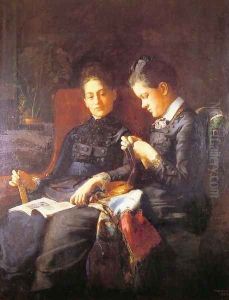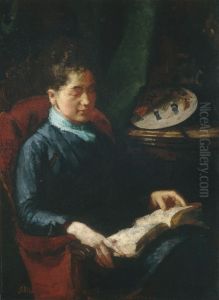Susan Macdowell Eakins Paintings
Susan Macdowell Eakins was an American painter and photographer who is sometimes overshadowed by her more famous husband, Thomas Eakins, but she was a talented artist in her own right. Born on September 21, 1851, in Philadelphia, Pennsylvania, Susan Macdowell was the daughter of a well-to-do family. Her early exposure to arts and culture laid the groundwork for her lifelong devotion to artistic pursuits.
Susan Macdowell studied at the Pennsylvania Academy of the Fine Arts, where she met Thomas Eakins, who was one of her instructors. Her artistic education was comprehensive, and she exhibited her work at various venues, including the Pennsylvania Academy. Her oeuvre included still-life paintings, portraits, and scenes of everyday life, showcasing her keen eye for detail and her ability to capture the subtleties of light and shadow.
In 1884, Susan married Thomas Eakins, and while her own artistic career was somewhat eclipsed by her husband's fame and the social expectations of women at the time, she continued to create art. Susan Eakins was also involved in photography, often collaborating with her husband on photographic studies, which included using photography as a tool to understand human anatomy for their artwork.
Despite her personal talent, Susan Eakins' work was not as widely recognized during her lifetime as that of her husband. After Thomas Eakins' death in 1916, Susan dedicated herself to preserving his legacy, organizing his papers and donating many of his works to museums. It wasn't until later in the 20th century that her contributions to American art began to receive more attention, and her paintings and photographs were more thoroughly studied and appreciated.
Susan Macdowell Eakins passed away on December 27, 1938, in Philadelphia. Today, her works are held in various collections and continue to be exhibited, contributing to the understanding of the role of women artists in the 19th and early 20th centuries. Her legacy is also tied to the advocacy for her husband's art, ensuring that both of their contributions to the arts remained part of the historical narrative.

